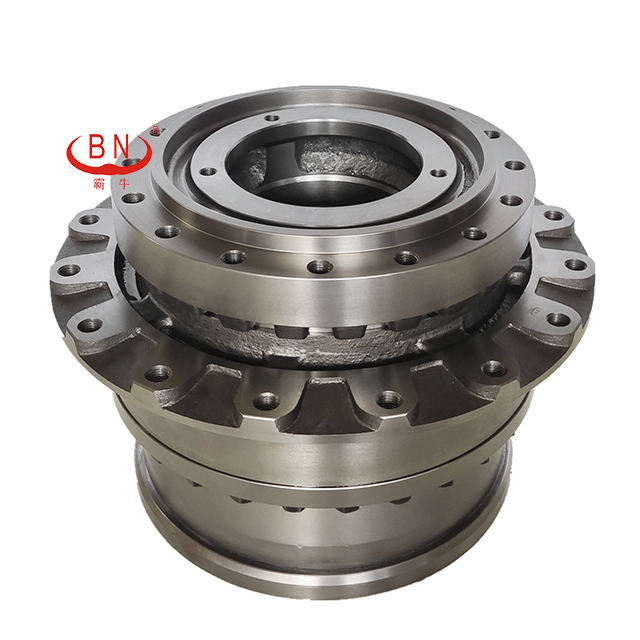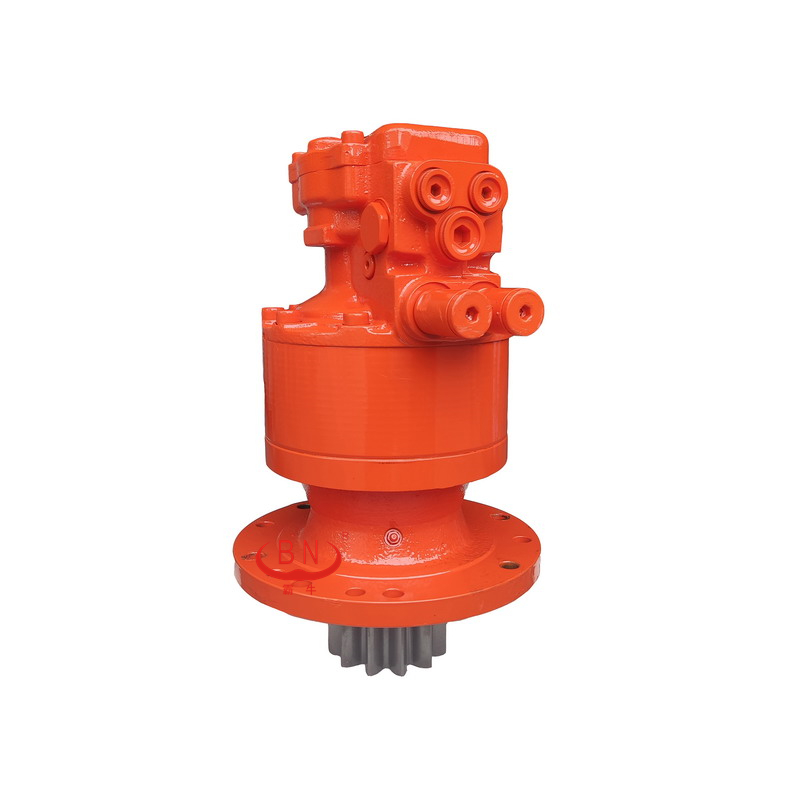Excavators are essential machines in the construction and mining industries, known for their versatility and strength. Central to the operation of an excavator is the final drive excavator, a crucial component that ensures the machine moves efficiently and powerfully. This article delves into the mechanics of how a final drive works on an excavator, the process of removing it, and its importance in overall machine performance.

How Does a Final Drive Work on an Excavator?
The final drive is the last stage of the excavator's power transmission system, converting hydraulic energy into mechanical energy to propel the machine's tracks. This component is a complex assembly of gears, bearings, and hydraulic motors, designed to handle the immense torque required to move the heavy machine across various terrains.
The final drive works in tandem with the excavator's hydraulic system. Hydraulic fluid is pumped into the final drive motor, creating pressure that drives a piston. This piston, in turn, pushes on a gear system, causing the gears to rotate. These rotating gears are connected to the drive sprockets, which engage with the tracks, moving the excavator forward or backward.
The final drive system in an excavator comprises several key components:
● Hydraulic Motor: Converts hydraulic fluid pressure into mechanical rotation.
● Planetary Gear System: A series of gears that reduce the motor's speed while increasing torque, essential for moving heavy equipment.
● Output Shaft: Transmits the rotational force from the gear system to the drive sprocket.
● Drive Sprocket: Engages with the tracks, enabling the excavator to move.
The combination of these components ensures that the excavator has enough power to move even on rough and uneven terrain. The final drive's ability to amplify torque while controlling speed is what makes excavators capable of heavy-duty tasks like digging, lifting, and moving large amounts of material.

How Does an Excavator Final Drive Work?
Understanding how an excavator final drive works involves a closer look at the interaction between the hydraulic motor and the planetary gear system. When the excavator operator activates the machine, hydraulic fluid is pumped from the hydraulic pump to the final drive motor. This motor is designed to convert the hydraulic pressure into mechanical energy through a rotating shaft.
The motor's shaft is connected to a planetary gear system. This system consists of a central sun gear, multiple planet gears, and an outer ring gear. As the motor's shaft rotates the sun gear, the planet gears also rotate around it, transferring motion to the outer ring gear. This setup allows the final drive to reduce the motor's speed while significantly increasing the torque output, which is necessary for moving the heavy tracks of the excavator.
The final output of this process is the rotation of the drive sprocket. The drive sprocket engages with the tracks, pulling or pushing them depending on the desired direction of movement. The ability to control this motion with precision is crucial for the excavator's performance, allowing the operator to maneuver the machine in tight spaces, climb slopes, or navigate challenging environments.
In summary, the excavator's final drive works by converting hydraulic energy into mechanical rotation through a series of gears, ultimately driving the machine's tracks with the necessary torque and control.
How to Remove a Final Drive from an Excavator
Removing a final drive from an excavator is a task that requires careful planning, the right tools, and a good understanding of the machine's structure. This process is typically undertaken when the final drive needs to be repaired or replaced due to wear and tear or damage.
Here is a step-by-step guide to removing a final drive from an excavator:
Preparation and Safety Measures:
● Ensure the excavator is parked on a flat and stable surface.
● Turn off the engine and disconnect the battery to prevent accidental startups.
● Use wheel chocks to prevent any movement of the excavator during the process.
Lifting the Excavator:
● Using the excavator's boom, lift the machine's body slightly off the ground. This can be done by lowering the boom while the bucket is placed on the ground. Ensure the excavator is stable before proceeding.
● Secure the machine with jack stands or blocks to prevent any accidental lowering.
Removing the Tracks:
● Release the tension on the tracks by loosening the track adjuster. This is typically done by releasing the grease valve, allowing the track to slacken.
● Remove the tracks from the drive sprocket. This may require assistance, as the tracks are heavy and cumbersome.
Disconnecting Hydraulic Hoses:
● Locate the hydraulic hoses connected to the final drive motor. These hoses supply hydraulic fluid to the motor, enabling it to function.
● Carefully disconnect the hydraulic hoses, ensuring you have a container ready to catch any leaking hydraulic fluid. Cap the hoses and the motor ports to prevent contamination.
Removing the Final Drive Bolts:
● The final drive is usually secured to the excavator's frame with a series of bolts. Using the appropriate tools, loosen and remove these bolts.
● Some final drives may also have additional components, such as guard plates or brackets, that need to be removed.
Removing the Final Drive:
● With the bolts removed, the final drive can now be detached from the excavator. This component is heavy and may require the use of a lifting device, such as a hoist or crane, to safely remove it.
● Carefully lower the final drive to the ground and move it to a secure location for inspection, repair, or replacement.
Inspecting and Cleaning:
● Before installing a new or repaired final drive, inspect the mounting area on the excavator for any signs of damage or wear.
● Clean the area to remove any debris, dirt, or old gasket material.
Reinstallation:
● The reinstallation process is essentially the reverse of the removal process. Ensure that all components are securely fastened, and the hydraulic hoses are correctly connected.
● After reinstallation, test the final drive to ensure it is functioning properly before returning the excavator to full operation.
Removing a final drive from an excavator is a complex task that should be undertaken with care. If you are unsure about any part of the process, it is advisable to consult the excavator's service manual or seek assistance from a professional technician.
Importance of Proper Final Drive Maintenance
The final drive is a critical component of an excavator, and its proper maintenance is essential for the longevity and performance of the machine. Regular inspections and timely repairs can prevent costly breakdowns and extend the life of the final drive.
Some key maintenance tips include:
● Regular Oil Changes: The oil in the final drive should be changed regularly to prevent contamination and wear. Use only the recommended type of oil for your specific excavator model.
● Inspecting Seals and Gaskets: Leaking seals or gaskets can lead to oil loss and contamination, which can damage the final drive. Regularly inspect and replace any damaged seals or gaskets.
● Checking for Unusual Noises: Any unusual noises coming from the final drive area, such as grinding or clicking, should be investigated immediately. These noises could indicate a problem with the gears or bearings.
● Monitoring Hydraulic Pressure: Ensure that the hydraulic pressure is within the recommended range. Too much or too little pressure can affect the performance of the final drive.
Proper maintenance of the final drive not only ensures the smooth operation of the excavator but also helps avoid costly repairs and downtime.

Conclusion
The final drive is an essential component of an excavator, responsible for converting hydraulic energy into the mechanical force needed to propel the machine. Understanding how it works, how to maintain it, and how to remove it when necessary is crucial for anyone operating or servicing an excavator. Whether you’re working with a Hitachi Excavaotrs or any other brand, ensuring the final drive is in good condition will keep your machine running efficiently and effectively.
For high-quality final drive components, especially for Hitachi Excavators, Hongxiang is a trusted supplier. Their expertise in manufacturing and supplying excavator parts ensures that your machine gets the best possible components, reducing downtime and improving performance. For more information or to make an inquiry, contact Hongxiang at info@hx-machinery.cn or vivian@hx-machinery.cn
excavator final drive
final drive excavator
Hitachi Excavaotrs
 English
English



















